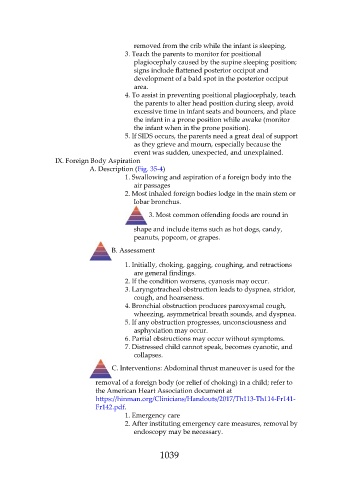Page 1039 - Saunders Comprehensive Review For NCLEX-RN
P. 1039
removed from the crib while the infant is sleeping.
3. Teach the parents to monitor for positional
plagiocephaly caused by the supine sleeping position;
signs include flattened posterior occiput and
development of a bald spot in the posterior occiput
area.
4. To assist in preventing positional plagiocephaly, teach
the parents to alter head position during sleep, avoid
excessive time in infant seats and bouncers, and place
the infant in a prone position while awake (monitor
the infant when in the prone position).
5. If SIDS occurs, the parents need a great deal of support
as they grieve and mourn, especially because the
event was sudden, unexpected, and unexplained.
IX. Foreign Body Aspiration
A. Description (Fig. 35-4)
1. Swallowing and aspiration of a foreign body into the
air passages
2. Most inhaled foreign bodies lodge in the main stem or
lobar bronchus.
3. Most common offending foods are round in
shape and include items such as hot dogs, candy,
peanuts, popcorn, or grapes.
B. Assessment
1. Initially, choking, gagging, coughing, and retractions
are general findings.
2. If the condition worsens, cyanosis may occur.
3. Laryngotracheal obstruction leads to dyspnea, stridor,
cough, and hoarseness.
4. Bronchial obstruction produces paroxysmal cough,
wheezing, asymmetrical breath sounds, and dyspnea.
5. If any obstruction progresses, unconsciousness and
asphyxiation may occur.
6. Partial obstructions may occur without symptoms.
7. Distressed child cannot speak, becomes cyanotic, and
collapses.
C. Interventions: Abdominal thrust maneuver is used for the
removal of a foreign body (or relief of choking) in a child; refer to
the American Heart Association document at
https://hinman.org/Clinicians/Handouts/2017/Th113-Th114-Fr141-
Fr142.pdf.
1. Emergency care
2. After instituting emergency care measures, removal by
endoscopy may be necessary.
1039

